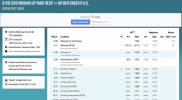Deepgreen
Established Member
This working today has prompted me to wonder if Woking to Guildford is signalled for bi-directional working, given the apparent 10 minute wait at Worplesdon for another train to overtake the subject train (at least I think that's what the ambiguous wording is supposed to mean). I hadn't thought it was, but may have missed it as I have never actually alighted at Worplesdon.

